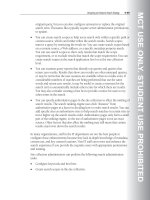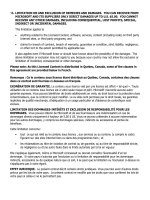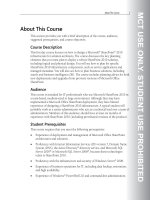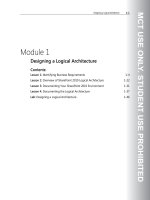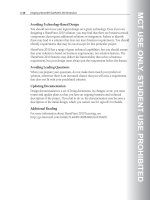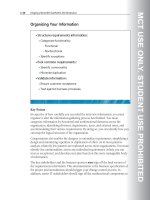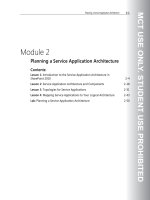Designing a Microsoft SharePoint 2010 Infrastructure Vol 1 part 23 pot
Bạn đang xem bản rút gọn của tài liệu. Xem và tải ngay bản đầy đủ của tài liệu tại đây (1.06 MB, 10 trang )
MCT USE ONLY. STUDENT USE PROHIBITED
Designing a Physical Architecture 4-17
Database
Default database
recovery model
Word Automation Services database Full
PerformancePoint service application database Full
PowerPivot application database Full
Other considerations may include the placement of the tempdb database in the
SQL Server file system. Testing and customer data show that insufficient disk I/O
for the tempdb database can significantly impede SharePoint Server 2010 farm
performance. To avoid this issue, allocate dedicated disks for the tempdb database.
For best performance, place the tempdb database on a RAID 10 array.
Note: In some organizations, a dedicated team of database administrators (DBAs) will
manage the computers running SQL Server. In these environments, you may need to
discuss the requirements for the SharePoint databases with the DBA. This discussion will
enable the DBA to understand the function and purpose of the database so that he or
she can select the relevant management options.
Additional Reading
For an overview of recovery models, see
For more information about how to choose the recovery model for a database, see
For more information about how to configure SQL Server databases for SharePoint
2010, see
MCT USE ONLY. STUDENT USE PROHIBITED
4-18 Designing a Microsoft® SharePoint® 2010 Infrastructure
Functional and Nonfunctional Design Mapping
Key Points
In any deployment project, there will be both functional and nonfunctional
requirements.
Functional requirements are those that the organization or end-user community
explicitly states or requests.
It is important that your solution design takes account of these functional
requirements because these typically drive the solution. These requirements may
help you to calculate the minimum number of servers that you require, based on
user load and feature requirements. They may also help you to calculate the
number of application servers that you require, because additional application
service features are necessary.
MCT USE ONLY. STUDENT USE PROHIBITED
Designing a Physical Architecture 4-19
This table shows examples of functional design mappings.
Requirement Feature Design impact
Team collaboration Collaboration sites Number of WFE servers
Browser-based slideshows Office Web Apps Number of application servers
Company forms InfoPath Forms Number of WFE and
application servers
In addition to functional requirements, you must also plan for nonfunctional
requirements. Nonfunctional requirements may be existing policies that you must
use, such as a security policy that details authentication methods. These
nonfunctional requirements may also be essential elements that the end-user
community does not directly specify, such as the auditing of documents, which
affect storage requirements.
This table shows examples of nonfunctional design mappings.
Requirement Design impact
Security Supported authentication methods and user stores
Governance Data life cycle impact on storage sizing
Business continuity Database size, backup/restore, and high availability
Capacity Storage sizing and media
MCT USE ONLY. STUDENT USE PROHIBITED
4-20 Designing a Microsoft® SharePoint® 2010 Infrastructure
Lesson 2
Designing Supporting Components for
SharePoint Deployments
In addition to designing your SharePoint deployment, you must also understand
the requirements of the supporting network and services. You should consider
supporting requirements such as Domain Name System (DNS) or the Active
Directory® directory service because the service behavior and requirements may
affect your farm topology or server placement within the network.
Objectives
After completing this lesson, you will be able to:
• List the requirements for Active Directory and DNS elements to support a
SharePoint farm.
• Identify design considerations for IIS.
• Identify design requirements for SQL Server.
MCT USE ONLY. STUDENT USE PROHIBITED
Designing a Physical Architecture 4-21
Requirements for Active Directory and DNS
Key Points
For SharePoint multiple-server farm deployments, you will require an Active
Directory domain infrastructure to support the authentication of service
application accounts. In addition, Active Directory is the most common store for
user accounts to control access to SharePoint content.
Although this is a common configuration for most internal corporate networks,
you should consider how this requirement affects extranet and Internet-facing farm
deployments. You may want to consider using read-only domain controllers
(RODCs) to assist in such environments.
You should also place domain controllers in the same Active Directory site as the
SharePoint farm servers for best performance. Configuring domain controllers in
the same Active Directory site as global catalog (GC) servers also ensures optimum
performance for GC lookups, such as using the People Picker.
In your DNS environment, you should ensure that you have provisioned any fully
qualified domain names (FQDN) for the WFE servers into the relevant DNS zones.
These FQDN entries may be required to enable Web application name resolution
such as alternate access mappings. Your SharePoint servers may also require
MCT USE ONLY. STUDENT USE PROHIBITED
4-22 Designing a Microsoft® SharePoint® 2010 Infrastructure
Internet name resolution, for example, if you want to display Internet-based feeds
on SharePoint Web pages.
MCT USE ONLY. STUDENT USE PROHIBITED
Designing a Physical Architecture 4-23
Design Considerations for IIS
Key Points
SharePoint 2010 uses the IIS component of Windows Server 2008 to receive and
respond to Web browser requests. You perform most SharePoint 2010
configuration tasks in SharePoint Central Administration, but you should be aware
that you may have to perform some Web service management tasks outside
SharePoint 2010.
You may require encrypted Web traffic, for example, to protect user access over the
Internet. In this scenario, you can use Secure Sockets Layer (SSL) to encrypt traffic
and establish a secure connection between the client and the WFE server. To
enable SSL, you require a properly configured Web server certificate. You perform
the installation of the certificate to the appropriate Web site in IIS.
You may also require additional host headers for a Web application, such as when
you configure alternate access mappings to enable multiple URLs for a single
content source. In this scenario, you must configure the host header in the IIS
Manager console.
MCT USE ONLY. STUDENT USE PROHIBITED
4-24 Designing a Microsoft® SharePoint® 2010 Infrastructure
You configure certain settings for the Web application, such as BLOB cache
settings, in the Web.config file. This file is stored in the directory for the Web
application on the WFE server(s).
If you have multiple WFE servers in the farm that host the same Web applications,
you must also consider how you duplicate and back up these settings on the
necessary WFE server.
MCT USE ONLY. STUDENT USE PROHIBITED
Designing a Physical Architecture 4-25
Design Requirements for SQL Server
Key Points
Most small and medium-size SharePoint farm deployments use a single database
server as a starting point. Only as transaction levels increase will administrators
consider scaling out to larger farm topologies.
There are several reasons to consider multiple database servers to support a
SharePoint 2010 farm:
• You can use additional computers running SQL Server to distribute I/O
operations and database access loads for heavy workloads. This configuration
can be for a service application, such as search, or to separate heavy
collaboration-based site collections from other content.
• You can use a second computer running SQL Server to implement a form of
database high availability that is known as database mirroring or log shipping.
Database mirroring copies transaction log data from the computer running
SQL Server that holds the live copy of the database to a standby server with a
second copy of that database. If the live database fails, the standby server can
take over database operations in a process known as failover. Database
MCT USE ONLY. STUDENT USE PROHIBITED
4-26 Designing a Microsoft® SharePoint® 2010 Infrastructure
mirroring requires a copy of the database and log files on both the live and
standby servers.
Log shipping is similar to database mirroring, but does not guarantee
transactional consistency, and cannot perform automatic failover.
• You can use additional computers running SQL Server to implement a form of
server high availability known as failover clustering. Failover clusters require
shared storage, such as a SAN, to share the database volumes and log files
among multiple instances of SQL Server running on different cluster nodes.
This arrangement offers additional scalability beyond database mirroring.
Based on licensing requirements, the following two failover cluster
configurations are available:
• You can use SQL Server Standard and Windows Server Enterprise on each
cluster node to create a two-node failover cluster.
• You can use SQL Server Enterprise and Windows Server Enterprise on
each cluster node to create a failover cluster that can scale up to 16 nodes.
Note: High availability options in themselves do not spread load between cluster nodes
and therefore do not improve performance in their own right.
Question: How can you provide additional computers running SQL Server to
accommodate heavy database workloads and provide high availability?
Additional Reading
For more information about high availability with SQL Server 2008, see
